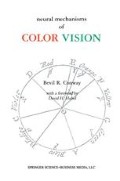Abstract
A world devoid of color is a gray and bleak one. Despite this, the specific benefits of color vision are difficult to quantify. Picasso said flippantly “when I run out of blue I use red” by which he meant that it is the brightness (or value) of a pigment and not its color that describes the 3-dimensional shape of objects. Matisse demonstrated this point beautifully in his painting La Femme au Chapeau (The Woman in the Hat, Paris, 1905; San Francisco Museum of Modern Art). A grayscale version shows that the values of the pigments preserve the shape of the woman’s face quite well: the color transitions do not interfere with an accurate representation of the play of light across her face (Livingstone, 2002). That the painting reads well as a face despite the radical color transitions shows that color is not an important cue to shape. Indeed, object shapes are easily recognizable even in dim light when color vision is absent. Moreover, many people function perfectly well with impaired color perception: as many as one in twelve men are red-green color-blind and many of them are unaware of it. But color cues are useful. In monkeys, for example, they assist the discrimination of nutritional foods (e.g. red berries) and of suitable procreative partners (e.g. male birds with the most colorful feathers).
“To explain colors, I suppose, that as bodies of various sizes, densities, or sensations, do by percussion or other action excite sounds of various tones, and consequently vibrations in the air of different bigness; so the rays of light, by impinging on the stiff refracting superficies, excite vibrations in the ether,—of various bigness; the biggest, strongest, or most potent rays, the largest vibrations; and others shorter, according to their bigness, strength, or power: and therefore the ends of the capillamenta of the optic nerve, which pave or face the retina, being such refracting superficies, when the rays impinge upon them, they must there excite these vibrations, which vibrations (like those of sound in a trunk or trumpet) will run along the aqueous pores or crystalline pith of the capillamenta, through the optic nerves, into the sensorium;—and there, I suppose, affect the sense with various colors, according to their bigness and mixture; the biggest with the strongest colors, reds and yellow; the least with the weakest, blues and violets; the middle with green; and a confusion of all with white, much after the manner that, in the sense of hearing, nature makes use of aerial vibrations of several bignesses, to generate sounds of divers tones; for the analogy of nature is to be observed.”
— Sir Isaac Newton, 1675 (in Newton, 1978)
Access this chapter
Tax calculation will be finalised at checkout
Purchases are for personal use only
Preview
Unable to display preview. Download preview PDF.
Author information
Authors and Affiliations
Rights and permissions
Copyright information
© 2002 Springer Science+Business Media New York
About this chapter
Cite this chapter
Conway, B.R. (2002). A history of color research. In: neural mechanisms of Color Vision. Springer, Boston, MA. https://doi.org/10.1007/978-1-4757-5953-2_1
Download citation
DOI: https://doi.org/10.1007/978-1-4757-5953-2_1
Publisher Name: Springer, Boston, MA
Print ISBN: 978-1-4419-5291-2
Online ISBN: 978-1-4757-5953-2
eBook Packages: Springer Book Archive

